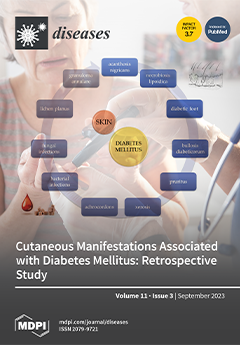Taeniasis is a neglected zoonotic disease responsible for serious health disorders, such as seizures, and may even cause death. Humans are the definitive host for the three species
Taenia solium (pork tapeworm),
T. saginata (beef tapeworm), and
T. asiatica, harboring the adult tapeworm in the small intestine. In this study, a structured questionnaire was circulated to assess the knowledge, attitudes, and practices (KAPs) regarding taeniasis among the rural and urban communities of Rawalpindi and Islamabad, Pakistan. A total of 770 individuals participated in the study. Of the total respondents, 44.4% had little knowledge about the disease and its impact, while the majority (70%) of respondents showed a willingness to participate in elimination campaigns by providing fecal samples. Most respondents kept raw meat separated from clean utensils (81.6%) and checked the internal temperature of meat when cooking it (75.1%). Regression analysis showed a significant association between age and knowledge, especially in the 20–30 years (
p < 0.05; OR 0.574) and 30 to 40 years (
p < 0.05; OR 0.553) age groups, and being a resident in Rawalpindi (
p < 0.05; OR 0.68) and other cities (
p < 0.05; OR 2.43), except Islamabad. Income ranges of 31,000–50,000 PKR (
p < 0.05; OR: 0.574), 51,000–70,000 PKR (
p < 0.05; OR 0.531), and above 70,000 PKR (
p < 0.05; OR 0.42) were significantly related to attitude, compared with individuals with incomes of 10,000–30,000 PKR. Income above 70,000 PKR (
p < 0.05; OR 0.87) and living in an urban area (
p < 0.05; OR 0.616) compared to a rural area were significant with practices. A positive attitude was observed regarding awareness and prevention of the disease. Awareness campaigns and providing health education could be key approaches to manage this disease in the general population of developing countries.
Full article






